West Bengal Board 10th Standard Life Science Exam Question Paper 2017 with Solutions – Free Download
West Bengal Board Class 10 Life Science 2017 Question Paper Solutions can be used as the best resource by the students to study well and prepare most proficiently for the board exams of Class 10. Here are the solutions for WBBSE Class 10 2017 Life Science Question Paper, which lays the base for the questions that are likely to be asked in the board exam paper. Referring to the West Bengal Board Class 10 Life Science 2017 Question Paper Solutions helps students face the exams confidently.
Students can click and download the solved or unsolved question paper PDFs from this article’s respective links. Students can access the PDFs from links and use the printable formats of the previous year question paper solutions. Meanwhile, the questions and answers can also be found online on the web-page.
The Madhyamik students are also urged to get familiar with the West Bengal Madhyamik Board Class 10 Life Science textbook’s complex concepts. Students can solve the solutions and revise the subject to get an overview of the WBBSE Class 10 Life Science exam question paper format. Students are advised to practice the previous papers while preparing for the board exams to ace the exams. Referring to these solutions will also help them gauge their performance and their preparation level for the final Class 10 exams. If the students solve these question paper solutions regularly, they can get the marks’ distribution for each section of the paper and know how to answer the exams most efficiently.
Download West Bengal Madhyamik Board 2017 Life Science Question Paper
Download West Bengal Madhyamik Board 2017 Life Science Solutions
West Bengal Madhyamik Board Class 10 Life Science 2017 Question Paper with Solutions
Scrollable PDF
Group-A
(It is compulsory to answer all the questions)
- Use complete sentences for the answer and choose the correct answer for each question with respective serial number [1×15=15]
1.1 Some flowers that open after sunrise and close after sunset. This is_________
- Photonasty
- Seismonasty
- Chemonasty
- Thermonasty
Answer: (a) Photonasty
1.2 Name the hormone from the following, which a person affected with Diabetes Mellitus is unable to secrete.
- Adrenaline
- Insulin
- Thyroxine
- Testosterone
Answer: (b) Insulin
1.3 Which is the part of the human brain associated with controlling the body temperature?
- Thalamus
- Cerebellum
- Hypothalamus
- Medulla oblongata
Answer: (c) Hypothalamus
1. 4 The stage of the separation of two sister chromatids at one stage of mitotic cell division is _____
- Prophase
- Telophase
- Anaphase
- Metaphase
Answer: (c) Anaphase
1.5 Choose the correct pair from the following:
(a) Budding-yeast
(b) Fragmentation-Earthworm
(c) Spore Formation-Amoeba
(d) Regeneration-Dryopteris
Answer: (a) Budding- Yeast
1.6 ______ phase of human development is associated with the maturity of the reproductive organ and reproductive gland.
- Childhood
- Adolescence
- Late Adulthood
- Infancy
Answer: (b) Adolescence
1.7 ______ from the following are the recessive traits of the pea plant.
(a) Wrinkled seed
(b) Yellow coloured seed
(c) Purple coloured flower
(d) Axial seed
Answer: (a) Wrinkled seed
1.8 How many types of gametes are formed from pea plants having genotype YyRr?
- 1
- 4
- 2
- 3
Answer: (b) 4
As the genotype YyRr is heterozygous for two genes with both dominant and recessive alleles of two genes, it will form a total of four types of gametes. The gametes are YR, Yr, yR and ry.
1.9 What is the probability of a haemophilic girl child being born to a haemophilic carrier mother and normal father?
(a) 75%
(b)100%
(c)50%
(d)0%
Answer: (c) 50%
1.10 The gas which was absent in the environment during the origin of life is _______
- Hydrogen
- Oxygen
- Methane
- Ammonia
Answer: (b) Oxygen
1.11 What is the feature of an analogous Organ?
(a) Different in origin and functions are also different
(b) Different in origin but functions are the same
(c) Indicates divergent evolution
(d) Identical in origin and structure
Answer: (b) Different in origin but functions are same
1.12 Which of the following absorbs the gas of the swim bladder in bony fishes?
- Red gland
- Anterior chamber
- Gastric gland
- Retia Mirabilia
Answer: (a) Red gland
1.13 Pseudomonas is associated with which of the following phases of the nitrogen cycle?
- Nitrogen fixation
- Nitrification
- Denitrification
- Ammonification
Answer: (c) Denitrification
1.14 Which of the following is the endangered species of the Eastern Himalayas’ biodiversity hotspots?
- Lion tailed Macaque
- Orangutan
- Red panda
- Nilgiri Thar
Answer: (c) Red panda
1.15 Which of the following are the diseases associated with air pollution?
- Diarrhoea, Typhoid, Hepatitis
- Hepatitis, Bronchitis, Deafness
- Bronchitis, Asthma, Lung cancer
- Lung cancer, polio, malaria
Answer: (c) Bronchitis, Asthma, Lung cancer
Group-B
2. Write answers as instructed for 21 out of the 26 questions given below [1×21=21]
Fill in the blanks with the proper words in the following sentences (any five) [1×4=4]
2.1 The process of necessary adjustment of focal length of the lens in the human eye is called____________
Answer: Accommodation
2.2 Adenine is a _________ type of nitrogenous base.
Answer: Purine
2.3 A disease created by a sex-linked gene is __________.
Answer: Genetic disease
One such example for a genetic disease is Haemophilia.
2.4 Name the earliest ancestor in the evolution of horses.
Answer: Eohippus
2.5 Which is an inflammable greenhouse gas that is produced from the paddy fields?
Answer: Nitrous oxide
2.6 _________ is a biosphere reserve located in West Bengal.
Answer: Sundarbans National Park
Decide whether the given statements are true or false (any five) [1×5=5]
2.7 Gibberellin hormone prevents immature shedding of leaf of plants.
Answer: False.
2.8 Ovum is only produced as a result of mitosis.
Answer: False
2.9 Self-pollination or cross-pollination can be exercised in flowers of a pea plant according to the need.
Answer: True
2.10 The fundamental tenet of the evolutionary theory of Darwin is the process of natural selection.
Answer: True
2.11 Degradable pollutant is responsible for biomagnification.
Answer: True
2.12 Flagella is the locomotory organ of Paramoecium.
Answer: False
Match the words of column A with the appropriate ones from column B and re-write the correct pair mentioning the serial numbers of both columns
(any five) [1×5=5]
| PART-A | PART-B |
| 2.13 blind spot | (a) Pollution of groundwater |
| 2.14 Cytokinesis | (b) The point of connection of retina and optic nerve |
| 2.15 44 A + XY | (c) Homologous organ |
| 2.16 Wings of a bat and bird | (d) Formation of cell plate |
| 2.17 Arsenic | (e) Pollen grain |
| 2.18 Transfer to stigma | (f) Sound pollution |
| (g) Chromosomal arrangement of human male |
Answer:
| PART-A | PART-B |
| 2.13 blind spot | (b) The point of connection of retina and optic nerve |
| 2.14 Cytokinesis | (d) Formation of cell plate |
| 2.15 44 A + XY | (g) Chromosomal arrangement of human male |
| 2.16 Wings of a bat and bird | (c) Homologous organ |
| 2.17 Arsenic | (a) Pollution of groundwater |
| 2.18 Transfer to stigma | (e) Pollen grain |
Answer any of the six from those given below in a word or a sentence [1×6=6]
2.19 Choose the odd one out and write it: TSH, ACTH, GTH, CSF
Answer: CSF or cerebrospinal fluid is the odd one out from TSH, ACTH, GTH and CSF.
2.20 Write one function of myelin sheath.
Answer: Myelin sheaths are cells that are part of our central nervous system and protect our nerve cells and act as an insulator which prevents short-circuiting in the neurons.
2.21 A pair of related terms are given below and on the basis of the relationship in the first pair write the suitable word in the gap of the second pair.
Prophase: Disappearance of nuclear membrane and nucleolus::
________ : Reappearance of nuclear membrane and nucleolus
Answer: Telophase
Prophase: Disappearance of nuclear membrane and nucleolus::
Telophase: Reappearance of nuclear membrane and nucleolus
2.22 Give an example of a variation inherited in man along the generation.
Answer: Even though not all variations are inheritable, factors like colour of the eye, hair colour, certain genes responsible for diseases are all inheritable.
2.23 Which type of chromosome of human carries the gene responsible for the disease thalassemia?
Answer: Autosomes of humans carry the gene responsible for the disease thalassemia.
2.24 Mention one morphological adaptation of cactus to prevent transpiration.
Answer: The leaves of the cactus are reduced to spines that help in reducing excess loss of water through transpiration.
2.25 Among the following four terms one includes the other three. Find out which term it is and write it.
Embryo, Meristematic tissue, Seed, Cryopreservation.
Answer: Meristematic tissue is the one term that included the other three terms in it.
2.26 Write the name of the cause of the latest concern regarding the environment of sunderbans.
Answer: The increased salinity resulting from the scarcity of the fresh water can cause climate change and concerns regarding the environment of the Sunderbans. Increase in human population is also another cause.
Group-C
Answer in 2 or 3 sentences any 12 out of the 17 questions given below. [2×12=24]
3.1 Give two differences between tropic movement and nastic movement.
Answer: Growth movements that take place in the direction of the stimulus are known as tropic movements. In this, the response acts on the protoplasm from one side. A tropic movement may be towards or away from the stimulus. These movements are non-directional responses to the stimuli. These movements are independent of the direction of the stimulus. These movements can be due to changes in turgor or growth. For e.g., the response of the touch-me-not (Mimosa pudica) plant to touch. However, this is not a growth phenomenon. Thus, we see that the tropic movements are growth-dependent while the nastic movements are growth independent.
3.2 Write two roles of GTH in the secretion of hormone from the reproductive glands in the body.
Answer: Gonadotropin releasing hormone regulates the secretion of LH (luteinizing hormone) and FSH (follicle stimulating hormone) from the anterior pituitary. The GnRH is produced by the hypothalamus and supplied through the bloodstream to the pituitary gland. Parts of the brain send out neural inputs which control the secretion of GnRH. In females, the secretion in particular is controlled by sex steroids through negative feedback. In addition, the hormone causes the release of progesterone and estrogen in ovaries. In males, GnRH causes the testicles to produce testosterone.
3.3 Categorise the following actions as natural or inherited reflex action.
- Willingness of infants for breastfeeding
- Cycling
- Sneezing
- Catching ball by Wicket-keeper with swiftness
Answer: Willingness of infants for breastfeeding- is an inherited and natural reflex action.
Cycling- is a conditioned reflex action that we learn after birth
Sneezing- is an inherited and natural reflex action
Catching the ball by the wicket-keeper with swiftness- is a conditioned reflex action
3.4 Write the parts of the Central Nervous System and the Peripheral Nervous System.
Answer: Central nervous system(CNS) consists of the brain and the spinal cord, while the Peripheral Nervous System(PNS) is made up of all the nerves travelling from the CNS to all the organs in your body, from the skin on your scalp to the tip of your toes.
3.5 Mention two importance of cell-cycle.
Answer: Cell cycle or cell division refers to the series of events that take place in a cell leading to its maturity and subsequent division. These events include duplication of its genome and synthesis of the cell organelles followed by division of the cytoplasm. Meanwhile, the cell division is important because of the following reasons:
-
-
-
- It helps in the survival and growth of organisms.
- Maintenance of chromosome number.
- Renewal of damaged cells
-
-
3.6 Distinguish between DNA and RNA based on the given features:
(a) Pyrimidine base
(b) 5 C sugar
Answer: (a) Pyrimidines (Cytosine. Thymine and Uracil as nucleobases) are one-carbon nitrogen ring bases that take part in the synthesis of RNA and DNA. DNA contains the sugar deoxyribose, phosphates, and a unique sequence of the nitrogenous bases adenine (A), guanine (G), cytosine (C), and thymine (T). RNA contains the sugar ribose, phosphates, and the nitrogenous bases’ adenine (A), guanine (G), cytosine (C), and uracil (U). DNA and RNA share the nitrogenous bases A, G, and C. Thymine is usually only present in DNA and uracil is usually only present in RNA.
(b) Meanwhile, the sugar in RNA is ribose and the sugar in DNA is deoxyribose. Both of these are 5-carbon of 5 C sugars.
3.7 Which agents perform the function of pollination in the following plants?
- Paddy
- Hydrilla
- Shimul
- Mango
Answer: (a) Wind is a good agent of pollination for Paddy. Hence, Paddy is known as Anemophilous or wind-pollinated flower.
(b) Surface pollination-In these the pollen floats on the surface and reaches the stigmas of the female flowers as in Hydrilla.
(c) Flowers like Shimul are large and brightly coloured, usually in red, yellow and odourless. These are pollinated with the help of birds that have good vision but a poor sense of smell. Hence, Shimul is a zoophilous flower.
(d) Mango is pollinated by insects such as flies, honey bees, wasps, ants, thrips and so on. Mango is also a cross-pollinated crop.
3.8 State the example of how dominant trait is expressed in the experiment of hybridisation.
Answer: Mendel in his first hybrid experiment took pea plants with tall and short characteristics and produced progeny from them. He observed the percentage of short plants and tall plants and found that all plants were tall. Parents that are pure for contrasting characters are crossed, only one form of the trait will appear and the dominant trait appears in the next generation. This best explains the Law of Dominance .
3.9 What would be the ratio of the phenotype and the genotype of the F2 generation in a monohybrid experiment in case of incomplete dominance?
Answer: When a true-breeding red (RR) and white (rr) coloured flowers of snapdragon are crossed, the F1 generation produces a pink coloured flower with Rr pair of alleles. Then the F1 progeny was self-pollinated. This resulted in red (RR), pink (Rr) and white (rr) flowers in the ratio of 1:2:1. The genotype ratio of F2 generation in the monohybrid cross by Mendel also gave the same ratio of 1:2:1. However, here the phenotype ratio has changed from 3:1 to 1:2:1. The reason for this variation is the incomplete dominance of the allele R over the allele r.
3.10 Show with the help of a cross, how colour blindness is inherited.
Answer:
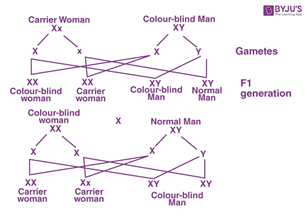
3.11 What are the reactants used and named the organic compound formed in the experiment of Miller and Urey and in connection with chemical origin of life.
Answer: Find out details about Miller and Urey experiment about Origin of life.
3.12 Write four important features modified in the evolution of horses.
Answer: The four features of a horse that have undergone evolutions from the primitive to the modern horse is as follows:
- Smaller body, head and neck
- Forelimbs with four and hindlimbs with three nailed digits
- No serrations upon the molar teeth
- The cement was incomplete
3.13 How does the Sundari plant excrete the excess salt from its body?
Answer: Halophyte group of plants such as Sundari plants survive high saline conditions. They thrive by maintaining the internal osmotic status. They excrete the excess salt through the specialised glands that are seen on the surface of the leaves.
3.14 What are the names of two microorganisms participating in the process of biological nitrogen fixation?
Answer: Nitrogen fixation is the essential biological process and the initial stage of the nitrogen cycle. In this process, nitrogen in the atmosphere is converted into ammonia (another form of nitrogen) by certain bacterial species like Rhizobium, Azotobacter, etc. and by other natural phenomena.
3.15 Mention two damages that were caused by Acid Rain.
Answer: Given here are some damages caused by Acid Rain:
- Acid rain is very harmful to agriculture, plants and animals. It washes away all nutrients which are required for the growth and survival of plants. Acid rain affects agriculture by the way how it alters the composition of the soil.
- It causes respiratory issues in animals and humans.
- It also affects the aquatic ecosystem.
3.16 What are the four damages of biodiversity caused by global warming?
Answer: Major damages of the biodiversity caused by global warming are given below:
- Global warming has led to an incredible increase in earth’s temperature, resulting in an increase in the melting of glaciers, which have led to an increase in the sea level. This could have devastating effects on coastal regions.
- Global warming has affected the coral reefs that can lead to a loss of plant and animal lives. Increase in global temperatures has made the fragility of coral reefs even worse.
- Global warming has led to a change in climatic conditions. There are droughts at some places and floods at some. This climatic imbalance is the result of global warming.
- A global shift in the climate leads to the loss of habitats of several plants and animals. In this case, the animals need to migrate from their natural habitat and many of them even become extinct. This is yet another major impact of global warming on biodiversity.
3.17 What are the major topics regarding biodiversity documented in the People’s Biodiversity Register(PBR)?
Answer: PBR or the People’s Biodiversity Register has a crucial role to play in promoting conservation, sustainable utilisation and documentation or chronicling of details regarding biological diversity. It also aims to put an end to the illegal and irregular harvesting of the biological resources.
Group-D
4. Answer any 6 of the questions from the alternatives given below. [5×6=30]
4.1 Draw a neat diagram of the vertical section of the eyeball of the human eye and label the following parts: [3+2=5]
- Cornea
- Lens
- Vitreous humour
- Retina
Answer:

Or
Draw a neat diagram of metaphase of mitosis of a plant cell or an animal cell division and label the following parts: [3+2=5]
- Chromosome
- Spindle fibre
- Polar region
- Centromere
Answer:
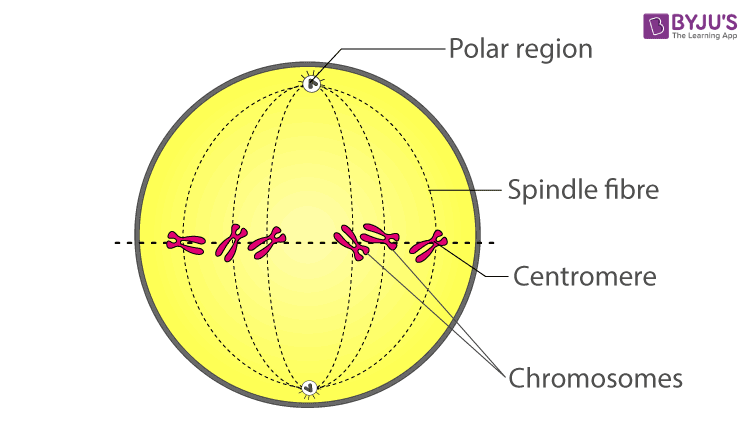
4.2 Explain the inter-relationships among chromosome, DNA and gene. Distinguish between the euchromatin and the heterochromatin on the following two aspects:
- Coiling
- Activity
Answer: A gene is a short section of DNA- Deoxyribonucleic acid, a molecule that carries the genetic instructions or the hereditary materials. Genes are functional units of heredity as they are made of DNA. It is a subdivision of DNA and is mainly passed down from parents to their children. Genes are generally organized and packaged in components called chromosomes. Overall, human beings have 23 pairs or 46 chromosomes. A set of chromosomes are passed on from a child’s mother, and another set of chromosomes comes from the child’s father. There are about thirty thousand genes in every cell of the human body. They play a vital role in controlling the functions of both DNA and RNA.
Meanwhile, Heterochromatin is a tightly packed DNA, which can be identified when stained in an extreme nuclear stain. Euchromatin is a lightly packed DNA, which can be identified when stained in a less nuclear stain.
More Details: Difference between heterochromatin and euchromatin
Or
How is micropropagation done? State what happens in the following three phases of sexual reproduction of flowering plants. [ 2+3=5]
- Production of gamete or reproductive cells
- Fertilization
- Formation of embryo and new plant
Answer: Micropropagation is the artificial process of producing plants vegetatively through tissue culture or cell culture techniques. In this artificial process of propagation, plants are produced invitro by asexual means of reproduction or by vegetative propagation.
- Meanwhile, flowers reproduce by a process called pollination. In this process, the male gametes are transferred to the female ovules where fertilization occurs and ovules grow into seeds within a fruit. Learn about sexual reproduction of plants.
- More about fertilisation in plants.
- The zygote thus formed during fertilisation, divides and develops into an embryo, and later into a seed. The ovary develops into a fruit. Fruits and seeds are formed post-fertilization. The ripened ovary goes on to become a fruit. Ovules give rise to seeds which contain the embryo in a protective covering.
4.3 With the help of a checkerboard show the types of off-springs that might be produced in a cross between a hybrid black guinea pig and a pure white guinea pig. State the law of segregation as proposed by Mendel. [3+2=5]
Answer: According to the law of segregation, every parent’s pair of genes or alleles divide and a single gene passes from every parent to an offspring. Which particular gene passes on in a pair is entirely up to chance.
| b | b | |
| B | Bb | Bb |
| B | Bb | Bb |
Or
Mention the symptom of Thalassemia disease. In many families mothers are labelled as responsible for the birth of a daughter. Demonstrate with the help of a cross that this belief is not justified. [2+3=5]
Answer: Thalassemia is a hereditary condition that affects the blood which leads to an abnormal form of haemoglobin. Haemoglobin is an important protein molecule present in RBC that carries oxygen. This disorder leads to the destruction of RBC which leads to anaemia. Meanwhile, find out details about sex-determination with image.
4.4 Mention two features of Internal structures on the basis of ‘which flipper of whales’ and ‘wings of birds’ are considered as homologous organs. How does a worker bee of a beehive communicate with other worker bees regarding source and location of food? [2+3=5]
Answer: Many mammals may have similar limb structures. For example ‘flipper of whales ‘ and ‘wings of birds’ are similar to the human arm made up of the humerus, the radius and the ulna. Hence, they can be called as Homologous organs. Homologous organs are defined as the organs of different animals that are having a similar structure but differ in their functions. The structure of the two different animals resemble but the functions of their organs vary. While the wings of birds are used for flying, the flippers of whales are used for swimming.
Honey bees also have an interesting form of communication – they “dance”. The honey bee performs a deliberate set of movements across its honeycomb – which conveys the location of nectar and pollen to other worker bees.
Or
Show the major evolutionary events with the help of a flow chart [5]
Answer:
4.5 What are the causes of asthma? What are the roles of Joint Forest Management in the conservation of Biodiversity? [2+3=5]
Answer: There are several factors responsible for triggering asthma attacks, and they vary from person to person. Meanwhile, India joint forest management (JFM) programme furnishes a good example for involving local communities in the management and restoration of degraded forests. In India, the joint forest management (JFM) programme furnishes a good example of involving local communities in the management and restoration of degraded forests. The programme has been in formal existence since 1988 when the state of Odisha passed the first resolution for joint forest management. JFM depends on the formation of local (village) institutions that undertake protection activities mostly on degraded forest land managed by the forest department. In return, the members of these communities are entitled to intermediary benefits like non-timber forest produces and share in the timber harvested by ‘successful protection’. The clear lesson from the dynamics of both environmental destruction and reconstruction in India is that local communities everywhere have to be involved in some kind of natural resource management. But there is still a long way to go before local communities are at the centre stage in decision-making. Accept only those economic or developmental activities, that are people-centric, environment-friendly and economically rewarding.
Or
Assess the causes of depletion of biodiversity with proper examples [5]
Answer: Find here the causes of depletion of biodiversity with proper examples.
4.6 Propose two conservation measures that could be taken to increase the number of Indian one-horned rhino. Make your opinions based on your experiences how sources of freshwater become polluted [2+3=5]
Answer: Efforts are currently ongoing in the country to protect the existing rhino population and also to increase the distribution of the species through the Indian Rhino Vision (IRV) 2020 programme.
-
- Success was achieved in restocking the rhino population in the World Heritage Site Manas National Park recently through wild to wild translocations.
- The one-horned Rhinoceros is also one of the 21 species identified for the Recovery programme for critically endangered species by the Ministry.
- The Ministry has also launched the “National Conservation Strategy for the Indian One-Horned Rhinoceros” with the goal to repopulate the Rhinoceros population in those areas also which used to hold the Rhinoceros earlier by augmenting the existing conservation efforts and strengthening them through scientific and administrative measures.
- Today, approximately 75% of the entire population of Greater One-horned Rhinoceros now occurs in India in the three States viz, Assam, Uttar Pradesh and West Bengal.
- The Census of Rhinoceros is undertaken at the State-level by the respective State Governments periodically.
Meanwhile, Water pollution can be defined as the contamination of water bodies. Water pollution is caused when water bodies such as rivers, lakes, oceans, groundwater, and aquifers get contaminated with industrial and agricultural effluents.
Or
Which conditions do you consider will declare one area out of two as a biodiversity hotspot? Give two examples of ex-situ conservation.
Answer: According to Conservation International, a region must fulfil the following two criteria to qualify as a biodiversity hotspot:
- The region should have at least 1500 species of vascular plants i.e., it should have a high degree of endemism.
- It must contain 30% (or less) of its original habitat, i.e. it must be threatened.
Meanwhile, Ex-situ conservation is the method of conserving all the living species in the artful habitats that reflect their natural living habitats. Ex-situ Conservation of Biodiversity comprises aquariums, botanical gardens, Cryopreservation, DNA banks, zoos, etc.

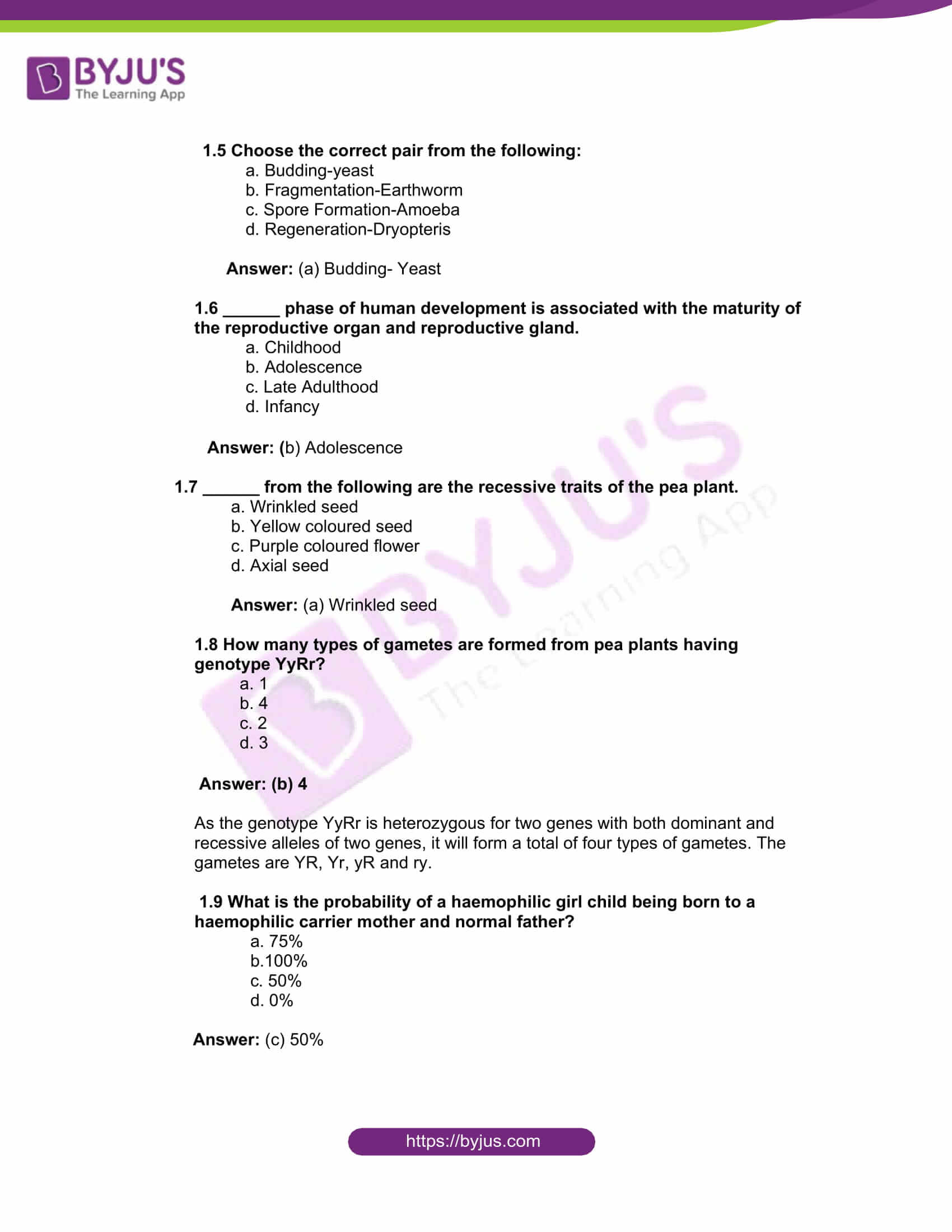
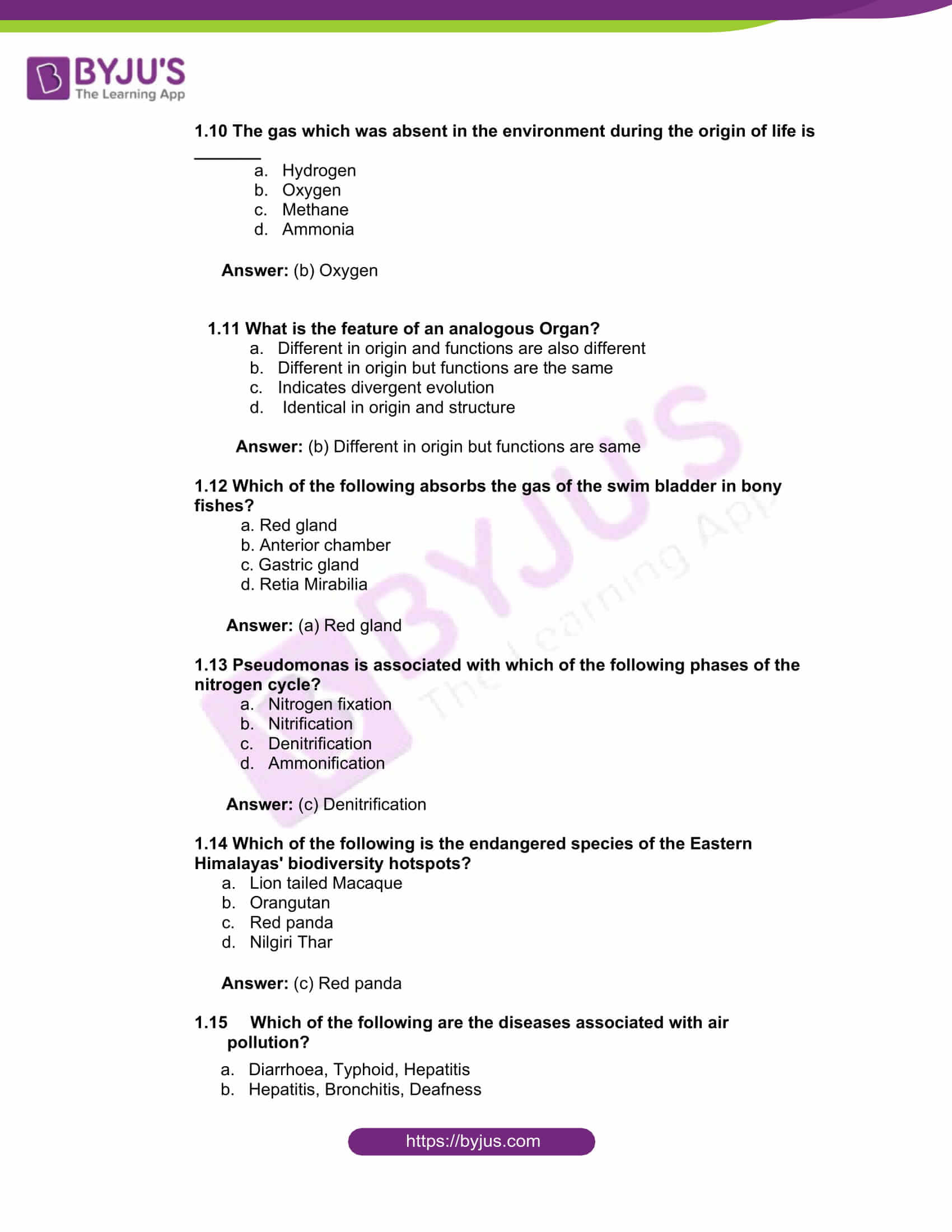

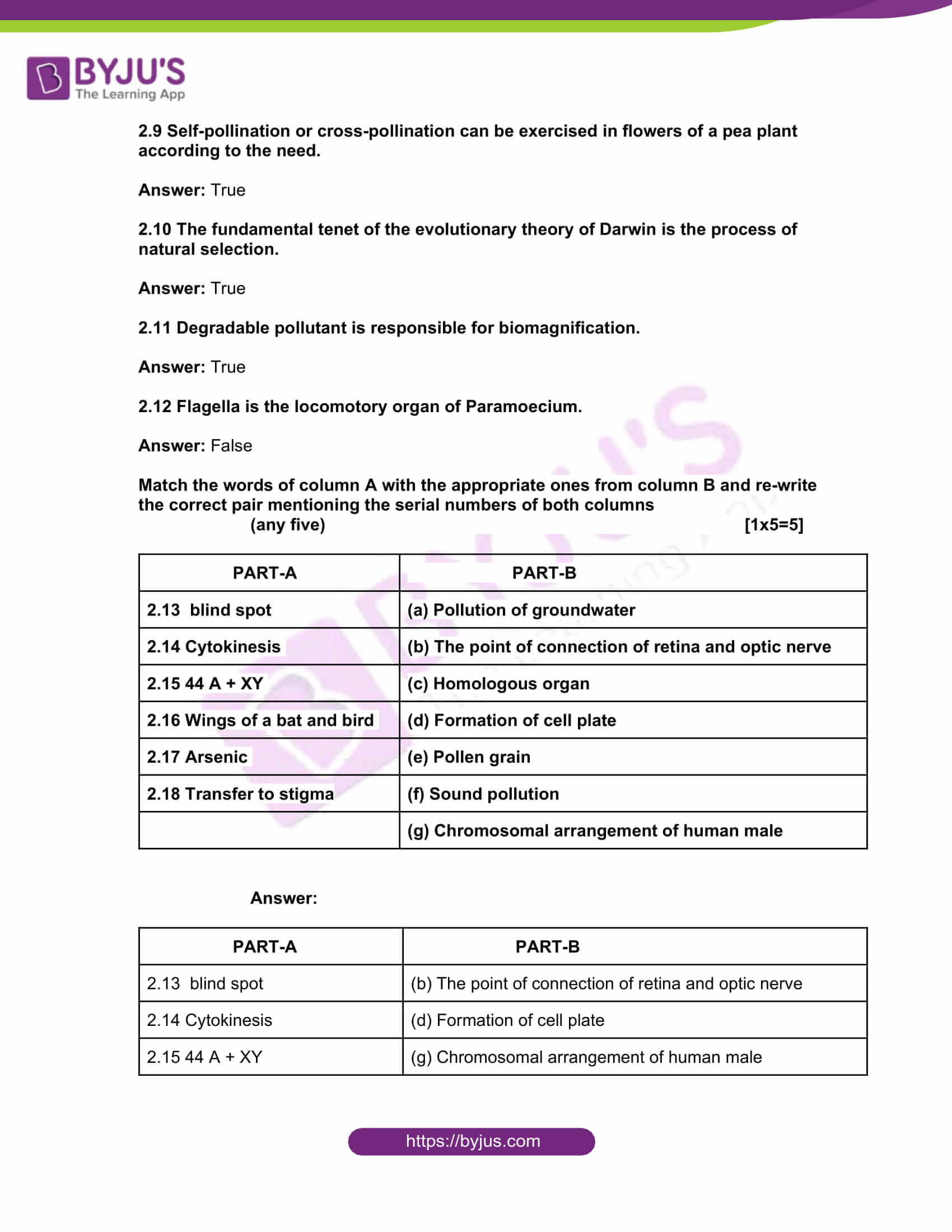

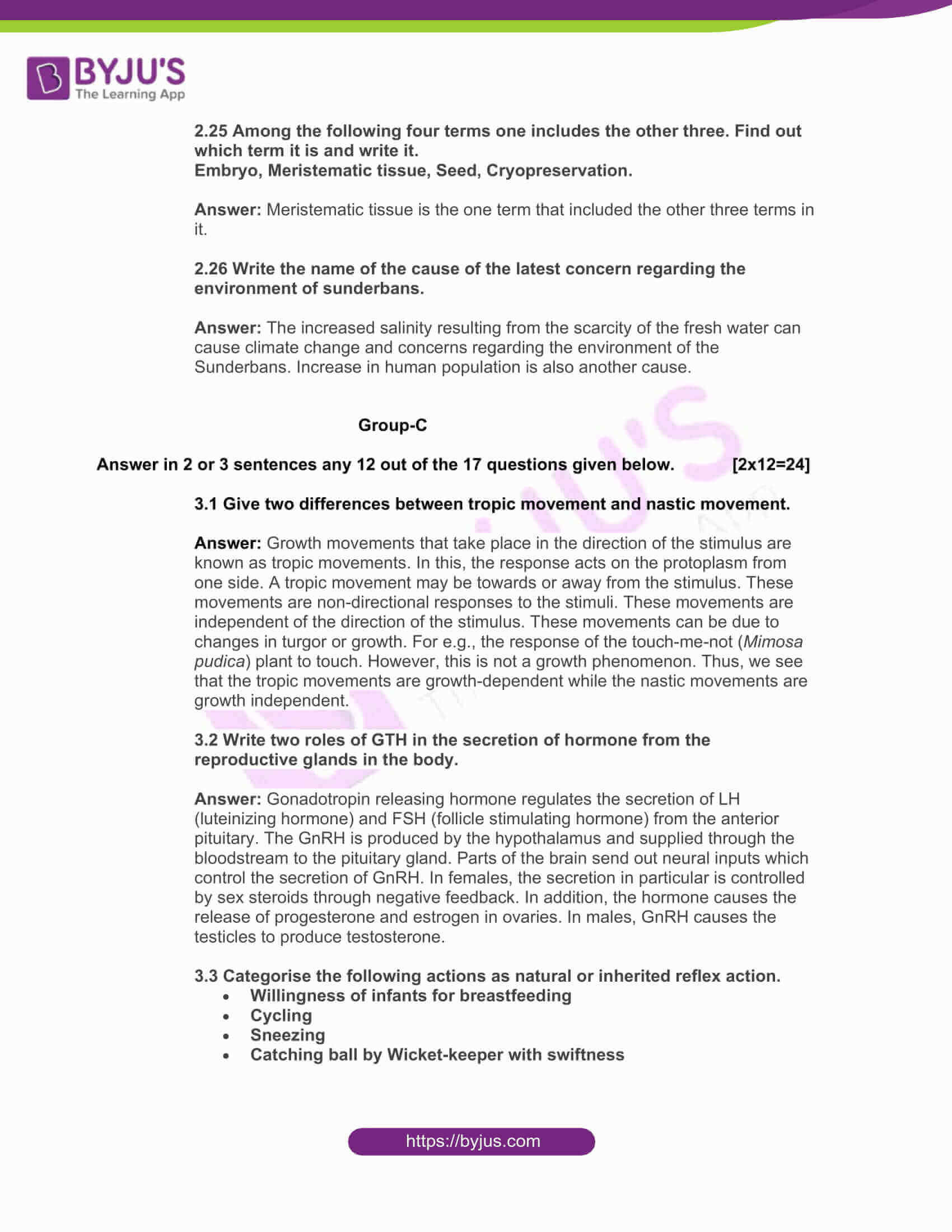
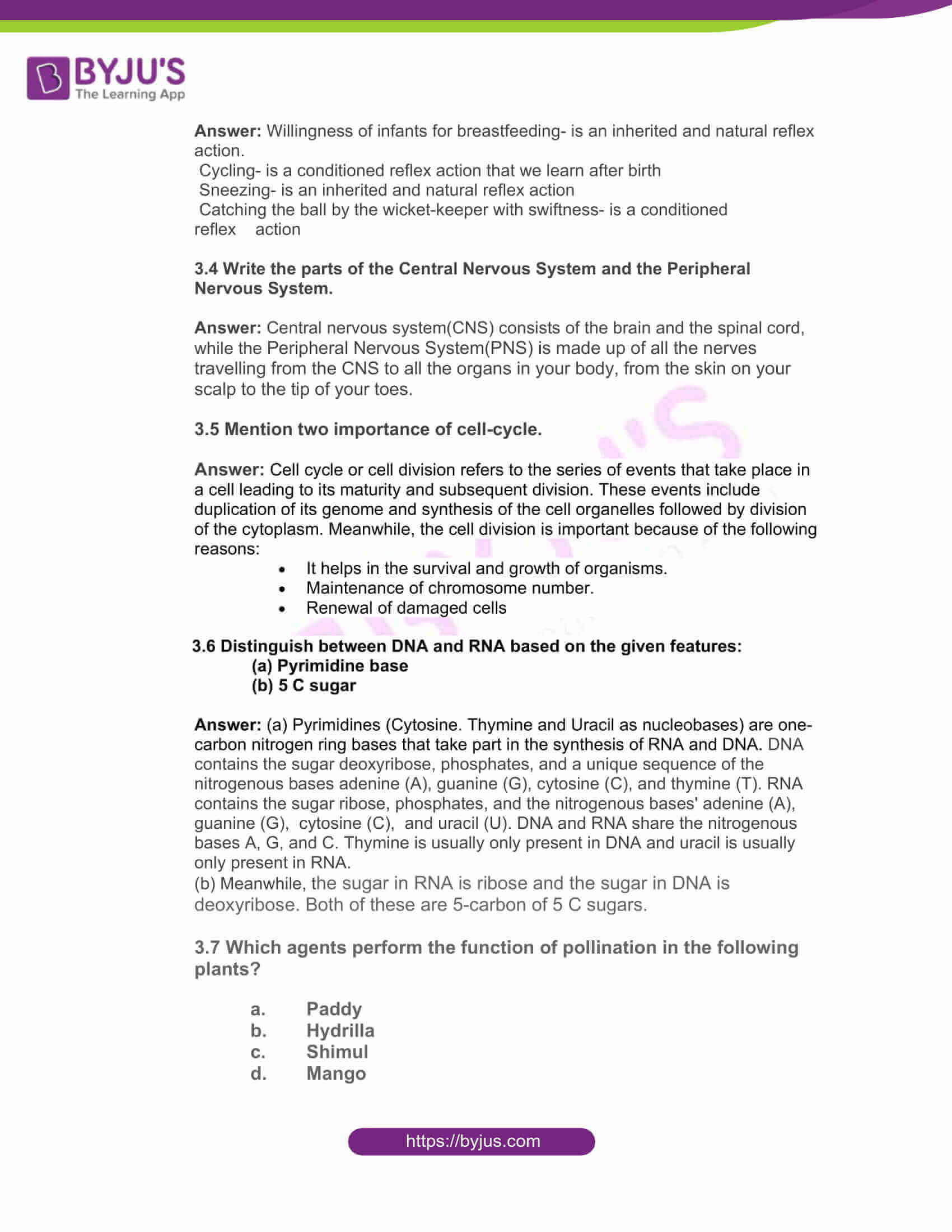
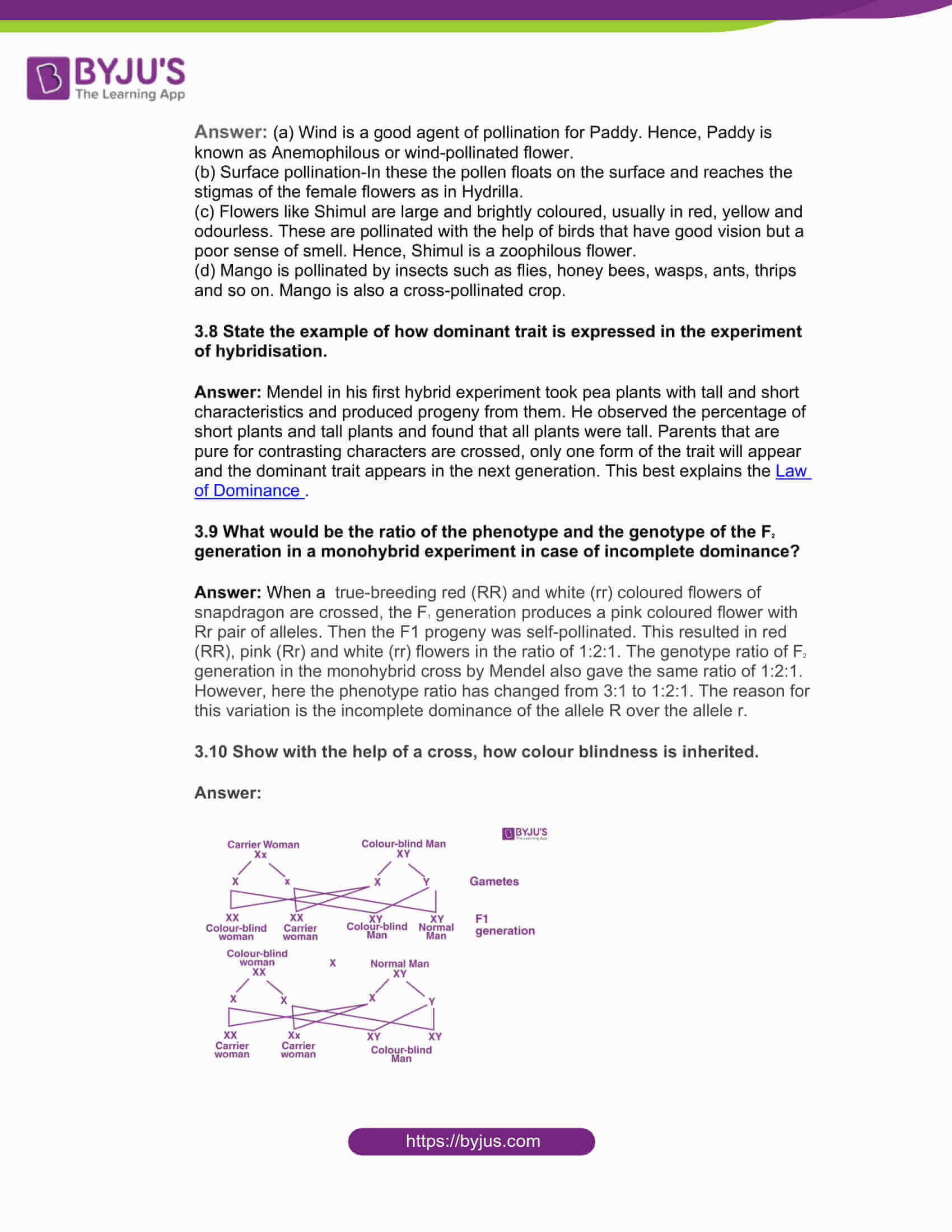

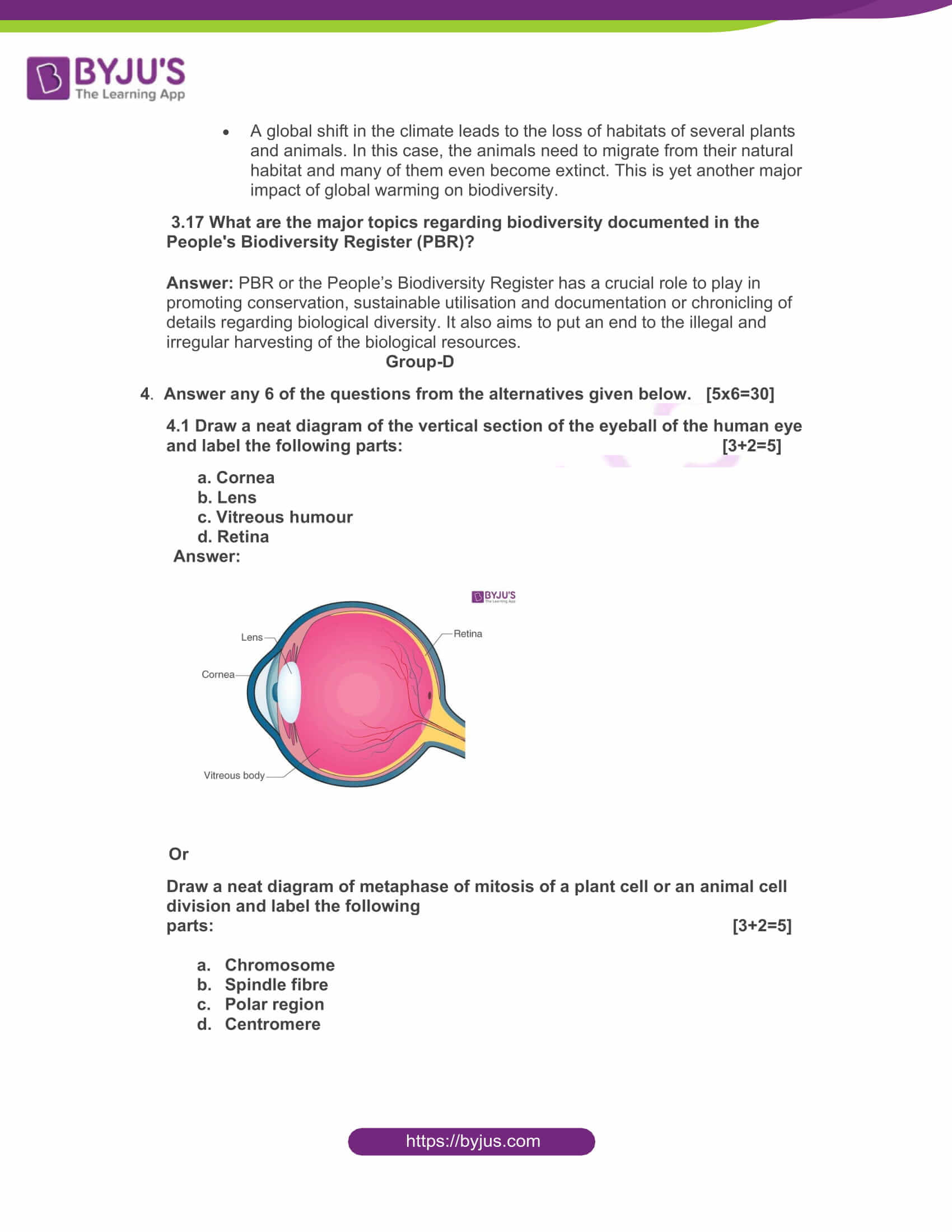
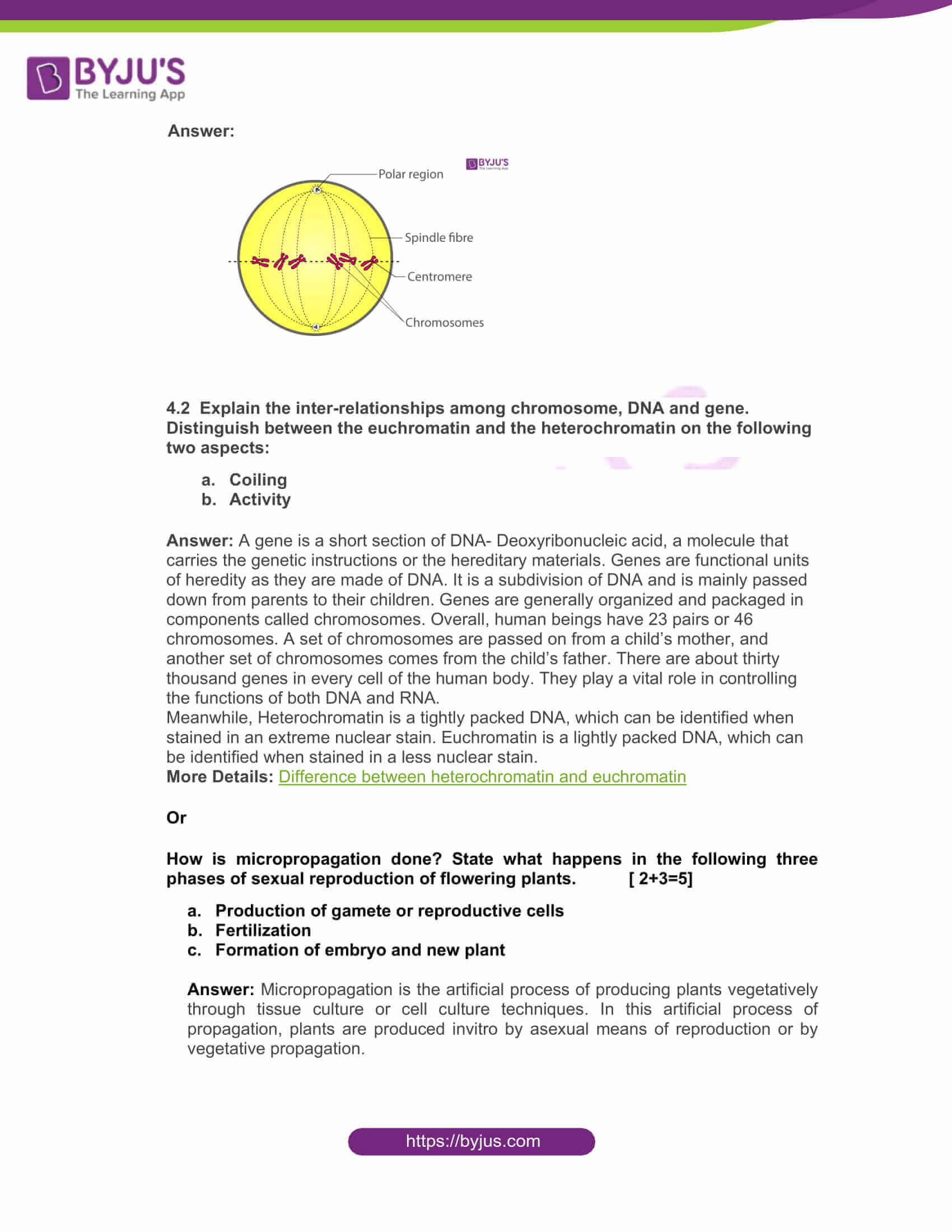
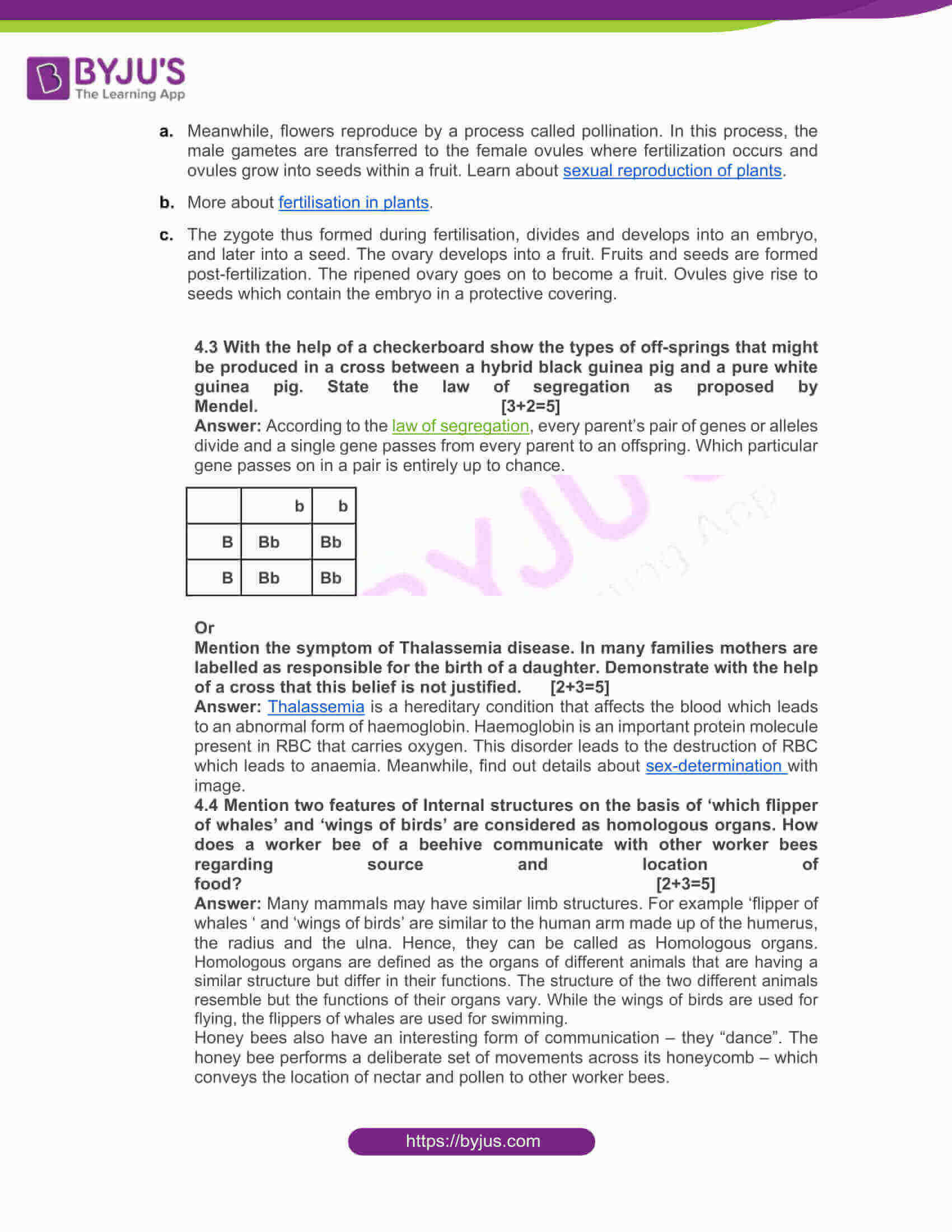
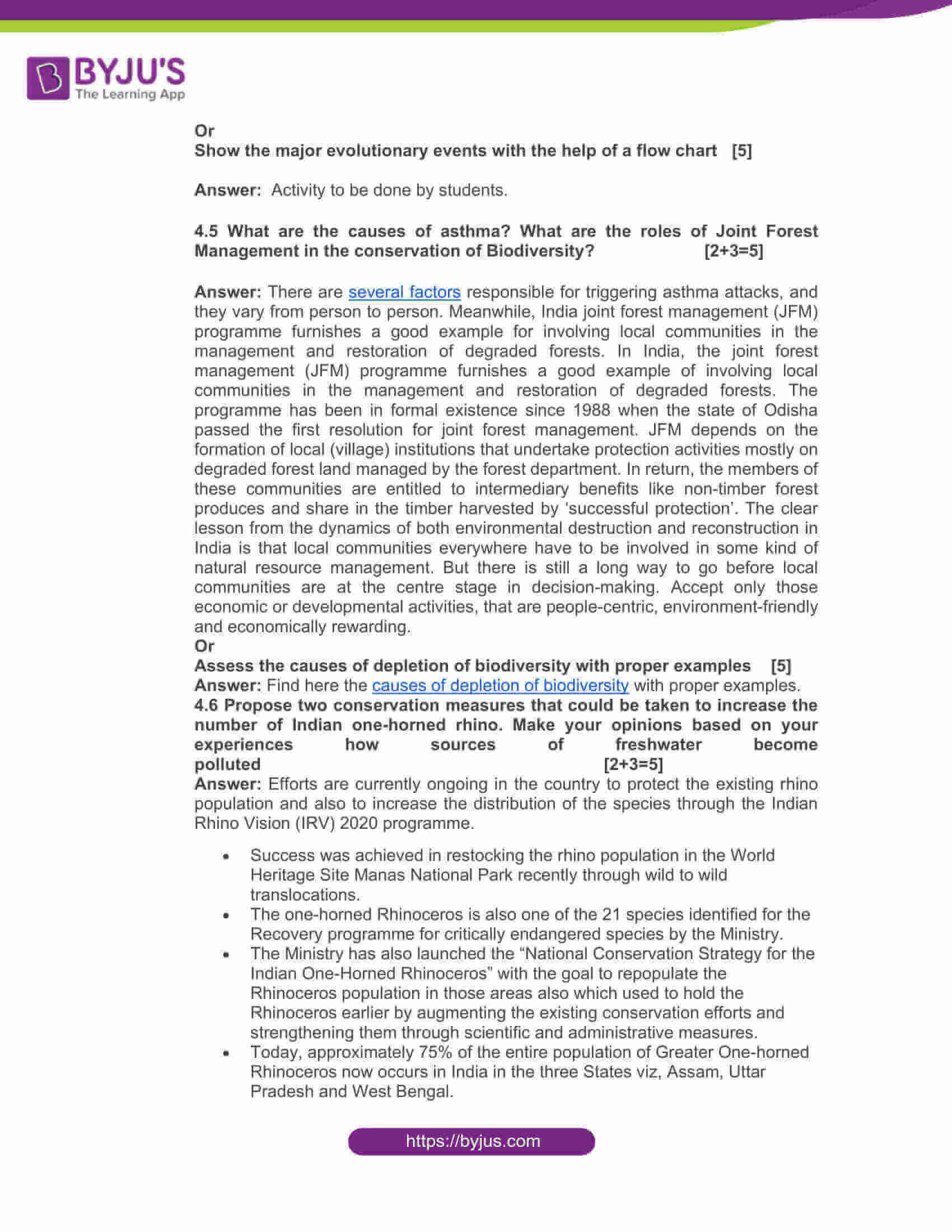


Comments